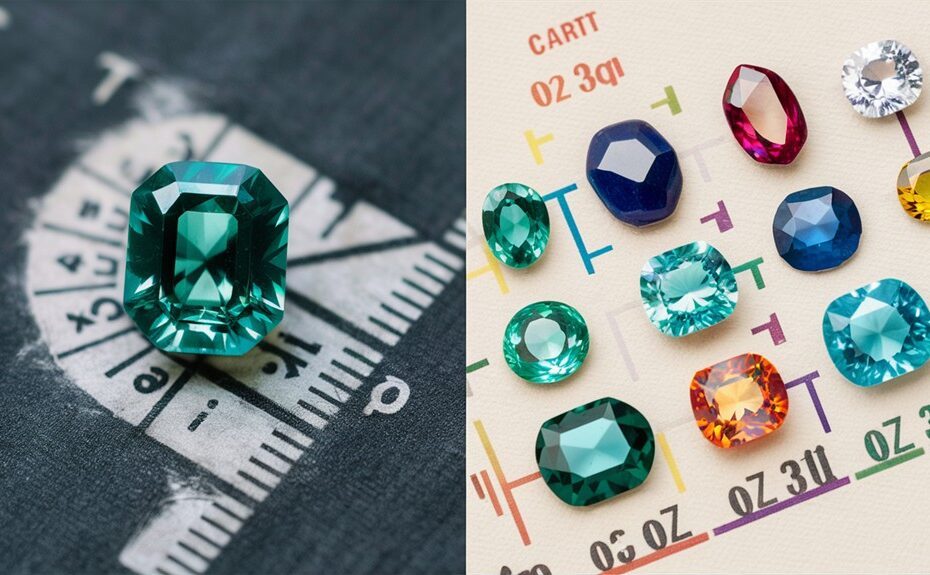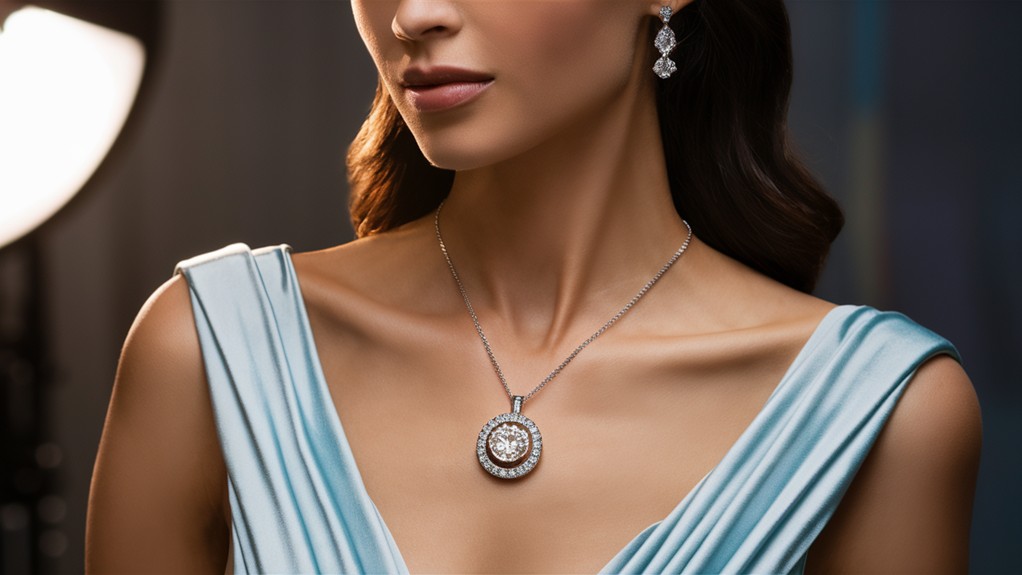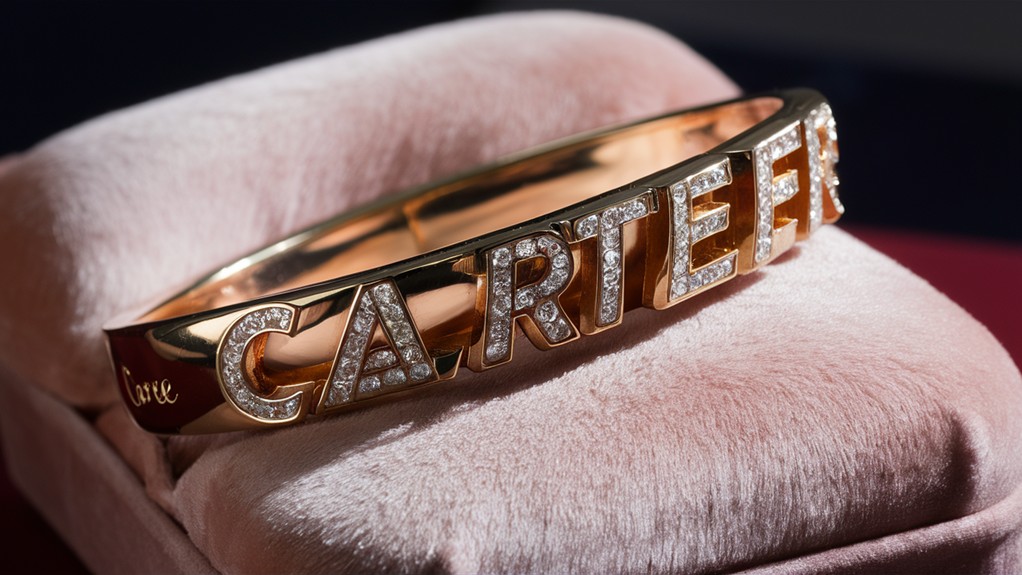When you're shopping for a gemstone, you'll inevitably come across measurements in millimeters, but what do those numbers really mean? You might know that a gemstone is 9x7mm, but how does that translate to carats, and more crucially, how does that affect its value? To make an informed purchase, you need to understand the relationship between a gemstone's measurements and its carat weight. However, this isn't always a straightforward calculation, and there are several factors to ponder. What are these factors, and how can you use them to your advantage when evaluating a gemstone?
Our Highlighted Points
- Gemstone size is measured in millimeters, and carat weight is measured in carats (1 carat = 0.2 grams).
- Density affects a gemstone's weight and size; a 1-carat diamond is smaller than a 1-carat opal due to different densities.
- Use a conversion chart to determine the approximate carat weight of a 9x7mm gemstone, considering its shape and cut.
- Carat weight, clarity, color, and cut determine a gemstone's value, with higher weights typically resulting in higher values.
- A gemstone's size and shape influence jewelry design, requiring a proportional setting to amplify its value and beauty.
Understanding Gemstone Measurement
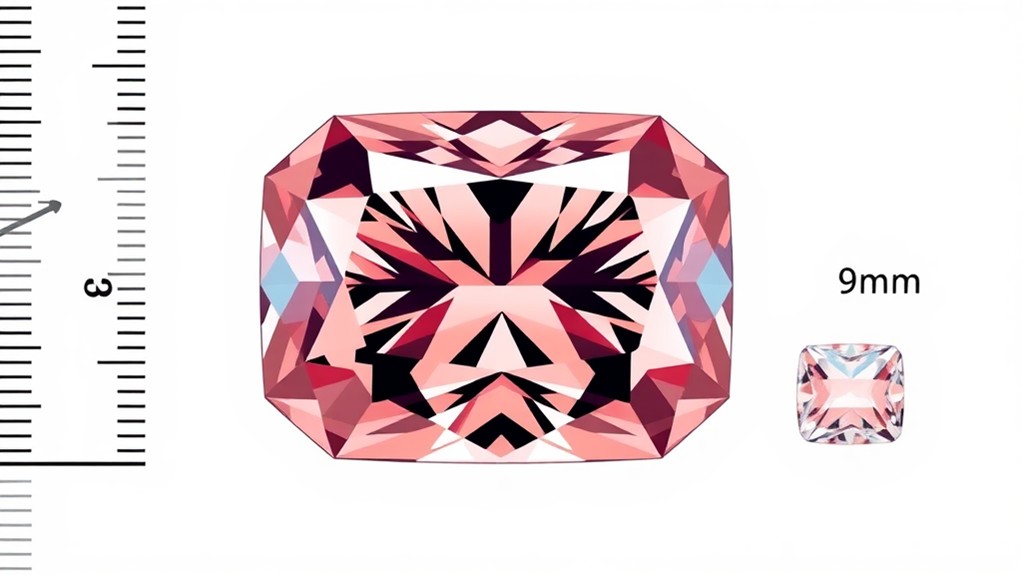
Gemstone Weight vs. Size
A gemstone's weight is measured in carats, with 1 carat equaling 0.2 grams.
However, a gemstone's size is measured in millimeters. The carat weight doesn't necessarily determine a gemstone's size, as different gemstones have varying densities.
For example, a 1-carat diamond is smaller than a 1-carat opal because of their different densities.
A gemstone's cut too affects its appearance and size.
A well-cut gemstone can appear larger than a poorly cut one of the same carat weight.
When evaluating a gemstone, consider both its carat weight and millimeter size to certify you get the best value for your money. In some cases, a gemstone with a lower carat weight may appear larger in millimeter size due to its cut and shape. It’s important to also consider the setting of the gemstone, as certain metals like rose gold can make the gemstone appear larger or smaller due to their color. Additionally, a rose gold karat comparison can also affect the overall appearance and value of the gemstone, so it’s essential to take these factors into account when assessing a gemstone’s worth.
Gemstone Shapes and Cuts
When considering a gemstone's value, you've likely looked at its carat weight and millimeter size.
However, the shape and cut of a gemstone can markedly impact its appearance and value. Different cuts can bring out the gemstone's natural beauty, brilliance, and fire.
Some popular gemstone shapes and cuts include:
- Emerald cut: rectangular in shape with rounded corners and elongated parallels, offering incredible brilliance and sparkle.
- Oval cut: with 58 facets, oval-cut gemstones sparkle beautifully, creating an illusion of a larger stone.
- Cushion cut: similarly having 58 facets, cushion-cut gemstones give gemstones an alluring brilliance.
- Princess cut: a variation of the brilliant cut, the princess cut is known for its square or rectangular shape with pointed corners.
- Brilliant cut: the most popular gemstone shape, the round brilliant cut has 57 facets that make the stone sparkle brilliantly.
Understanding the different gemstone shapes and cuts can help you make informed purchasing decisions and appreciate the craftsmanship that goes into cutting a gemstone.
Factors Affecting Weight and Size
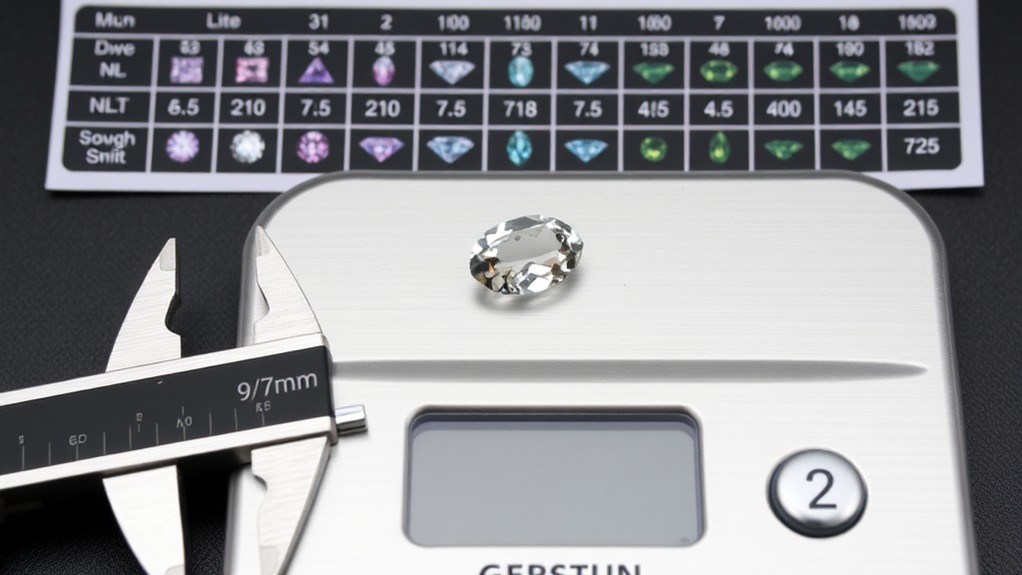
To better understand this relationship, consider the following factors that affect a gemstone's weight and size:
- Density: Different gemstones have varying densities, which impact their carat weight.
- Cut: The cut of a gemstone can greatly affect its size and weight.
- Proportions: The proportions of a gemstone's dimensions can additionally influence its carat weight.
When converting mm to carat, it's vital to use a carat weight chart to determine the approximate carat weight of a gemstone.
Keep in mind that this is just an estimate, as the actual carat weight may vary depending on the factors mentioned above.
Gemstone Conversion Charts
Now that you're familiar with the factors affecting a gemstone's weight and size, you're ready to investigate the tools that help you determine its carat weight. Gemstone conversion charts are vital for making accurate measurements, as the same mm size can correspond to different carat weights depending on the gemstone type. These charts provide an approximate carat weight for each shape and size of gemstone, taking into account factors like density and cutting style.
| Shape/Cut | Carat Weight (approx.) |
|---|---|
| Round Brilliant | 0.5-1.5 carats for a 5-7mm stone |
| Emerald Cut | 2.25-3.5 carats for a 9x7mm stone |
| Oval Cut | 1.5-2.5 carats for a 7x5mm stone |
Gemstones have different densities, which affect their carat weight. For example, a 9x7mm emerald-cut ruby has a carat weight of approximately 3, while an emerald and blue sapphire of the same cut and dimension can have carat weights of 2.25 and 2.45, respectively. Using a gemstone size chart and conversion charts can help you accurately determine the carat weight of a gemstone based on its millimeter measurements. These charts are crucial for making accurate calculations, as the same mm size can correspond to different carat weights depending on the gemstone type.
Converting 9x7mm to Carats

Understanding the intricacies of gemstone measurements is crucial for converting a 9x7mm stone to carats.
As you explore the world of gemstones, you'll find that carat weight is the unit of weight used to measure gemstones, which can vary greatly depending on the type of stone, cut, and density.
For instance, a 9x7mm emerald-cut ruby can have a carat weight of 3, while an emerald and blue sapphire of the same cut and dimension can have carat weights of 2.25 and 2.45, respectively.
To determine the carat weight of a gemstone, you need to know its specific gravity.
This value ranges from 2.6 for opal to 3.5 for sapphire.
You can use a conversion chart or consult a gemologist to estimate the carat weight of a 9x7mm gemstone.
Keep in mind that the actual size of the gemstone is just one factor in determining its carat weight.
The Size Chart can provide a general idea, but the calculation process is complex and influenced by multiple factors.
Measuring Gemstone Size Accurately
Measuring gemstone size accurately requires precision and the right tools, especially after considering the variables involved in converting millimeters to carats.
To provide an accurate measurement of gemstone size and value, you need to have a good understanding of the weight used to measure gemstones and the tools required to take precise measurements.
When measuring gemstone size, you'll need to choose the right tools for the job.
- Calipers: Digital or dial calipers can provide precise measurements of a gemstone's dimensions.
- Micrometer: A micrometer can be used to measure the thickness of a gemstone, which is vital for calculating its weight.
- Protractor: A protractor can help you measure the angles and aspects of a gemstone, which can affect its size and value.
Gemstone Weight and Density
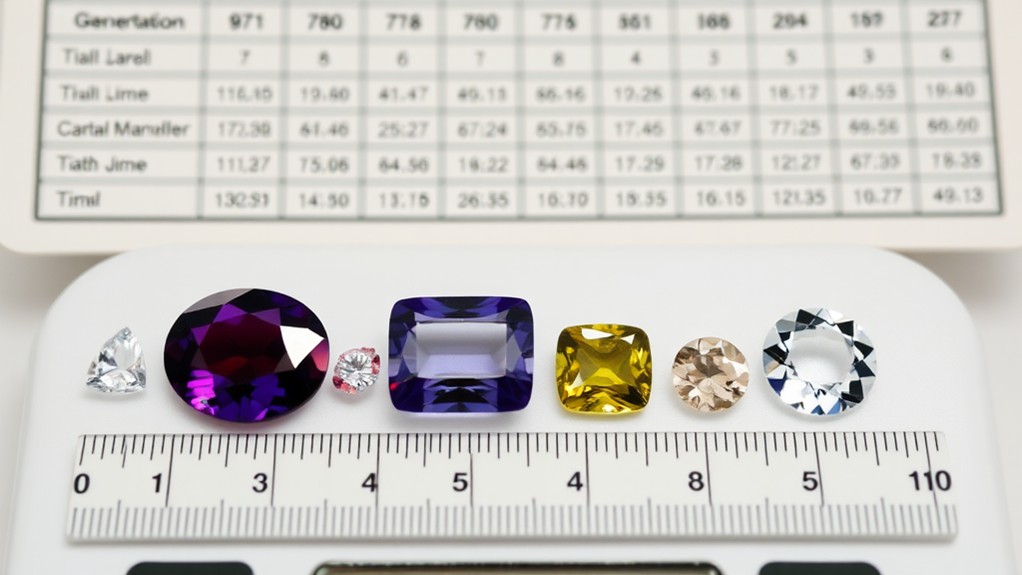
| Gemstone | Density (g/cm³) | Carat Weight (per mm³) |
|---|---|---|
| Diamond | 3.52 | 0.006 |
| Sapphire | 4.00 | 0.007 |
| Emerald | 2.76 | 0.005 |
| Ruby | 4.00 | 0.007 |
| Topaz | 3.49 | 0.006 |
When evaluating the value of a gemstone, consider both its weight and density. A gemstone with a high density will appear smaller than a gemstone with a lower density, regardless of whether they have the same carat weight. Understanding the relationship between weight and density is vital in determining the true value of your gemstone. By considering these factors, you can make informed decisions when purchasing or valuing a gemstone.
The Role of Cut in Gemstone Size
When considering a gemstone's size, don't overlook the cut – it plays a crucial part.
A well-cut stone can appear larger than its carat weight suggests, while a poorly cut stone can appear smaller. The shape and proportions of a gemstone likewise impact its perceived size.
For instance, elongated shapes like ovals and marquises often appear larger than round or square shapes.
To better understand the role of cut in gemstone size, consider the following factors:
- Proportions: A gemstone's length-to-width ratio can greatly impact its perceived size. For example, a round stone with a 1:1 ratio will appear smaller than an oval stone with a 1.5:1 ratio.
- Depth: The depth of a gemstone, measured as its height from the culet to the table, can likewise impact its size. A deeper stone may appear smaller on account of hidden weight.
- Cut type: The type of cut, such as brilliant, step, or mixed, can influence a gemstone's size. Use a Chart to compare different cuts and see how they affect the carat weight and total appearance of a gemstone, making it appear larger or smaller.
Gemstone Size and Value Relationship

The size of a gemstone substantially impacts its value, making it a key factor for collectors and buyers. As you ponder purchasing a gemstone, vital knowledge of the relationship between size and value is imperative.
| Gemstone Size | Carat Weight |
|---|---|
| Small (5-7mm) | 0.25-0.50 carats |
| Medium (7-9mm) | 0.50-1.00 carat |
| Large (9-11mm) | 1.00-2.00 carats |
When evaluating a gemstone, the carat weight is a vital element that affects its value. One carat is equivalent to 200 milligrams, and a higher carat weight typically results in a more valuable gemstone. However, it's not the only aspect to ponder. The quality of the gemstone, including its clarity, color, and cut, plays a vital role in determining its value. A gemstone with a larger surface area may be more valuable owing to its rarity and the skill required to cut and polish it. Ultimately, the value of a gemstone is determined by a combination of its size, quality, and market demand.
Practical Applications of Gemstone Size
One key factor in working with gemstones is how their size impacts the general design of your jewelry piece.
The size of a gemstone, whether it's a princess cut or a different shape, materially affects the total visual appeal and value of the piece.
As you work with gemstones, you'll need to ponder how their size influences the design and value of your jewelry.
- Balancing proportions: Verify that the gemstone is proportional to the rest of the jewelry piece. A large gemstone can overwhelm a delicate setting, while a small gemstone can get lost in a bulky design.
- Calculating carat weight: Accurately convert millimeter measurements to carats to determine the gemstone's value. This is especially crucial when working with gemstones of different densities and chemical compositions.
- Selecting settings: Choose a setting that complements the gemstone's size and shape. A well-designed setting can amplify the gemstone's value and beauty, while a poorly designed setting can detract from it.
Frequently Asked Questions
How Many Carats Is a 9×7 Mm Stone?
You're wondering how many carats a 9x7mm stone is. Generally, a 9x7mm gemstone is approximately 2.25-3.48 carats, but you'll get an exact weight by knowing the stone type, cut, and density, so it's best to consult a gem expert.
How Many Carats Is a 9×7 Emerald Cut?
You'll find a 9x7mm emerald-cut gemstone can weigh approximately 2.25-3.00 carats, but it depends on the stone's type and density. Knowing the specific gravity helps – for emeralds, it's around 2.45 carats, and for rubies, it's around 2.85 carats.
How Many Millimeters Is 1 Carat?
You want to know how many millimeters is 1 carat, right? Well, it's not a straightforward answer, as it depends on the gemstone's shape and cut. For a round brilliant diamond, 1 carat is about 6.4mm in diameter.
How Many Carats Is 8x10mm?
You're looking for the carat weight of an 8x10mm gemstone. Generally, this size stone weighs between 2.25 to 3.5 carats, depending on the stone type, cut, and density, with denser stones like rubies and sapphires weighing more.
